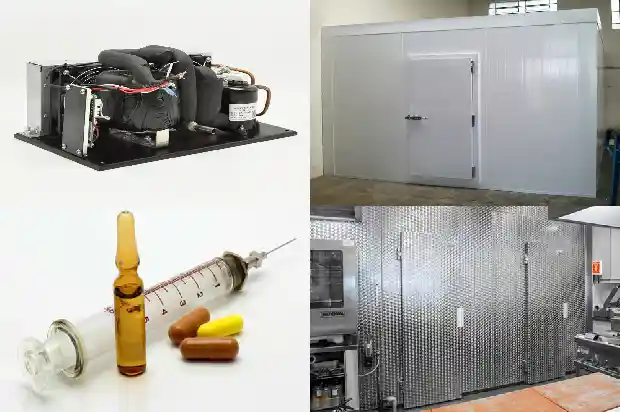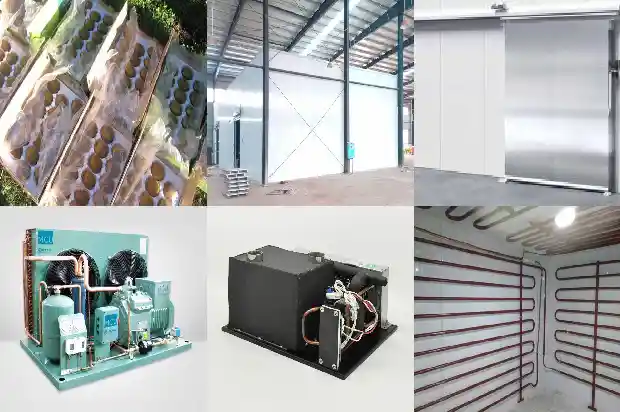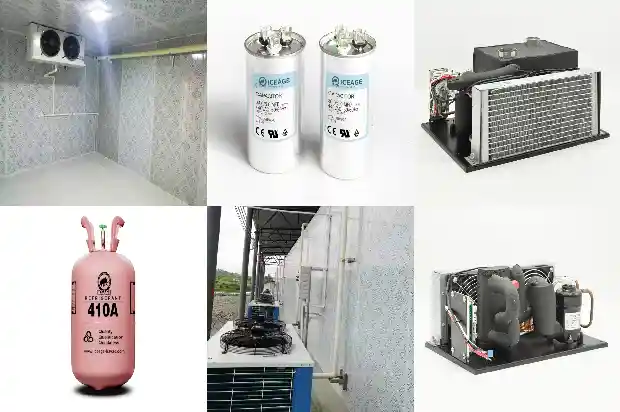How Much Do You Know About the Chilled Water System of Large - scale Central Air - conditioners?
2025-02-25
Today, let's study the chilled water system in large - scale central air - conditioning systems together.
In an air - conditioning system, it includes the cooling water system, the chilled (refrigerant) water system, and the condensate water drainage system.
The function of our water system is to provide cooling and heating for our air - conditioning units.
Air - conditioning chilled water: It is the working medium that delivers the cooling capacity prepared by the evaporator to the end - use devices of the air - conditioner through the chilled water pump, also known as refrigerant water.
We can regard the chilled water system of the air - conditioner as the blood circulation of the human body.

Composition of the Air - conditioning Chilled Water System
In the chilled water system of the air - conditioner, its main components are the water pipe system, the water pump, and various accessories, such as pressure gauges, thermometers, valves, filters, air - release valves, expansion tanks, and its water - make - up system, etc.
In the chilled water system of the air - conditioner, its main components are the water pipe system, the water pump, and various accessories, such as pressure gauges, thermometers, valves, filters, air - release valves, expansion tanks, and its water - make - up system, etc.
What Does the Design of the Air - conditioning Chilled Water Scheme Include?
First, when designing the air - conditioning chilled water system, we need to determine its form selection and zoning, consider adjustment and control measures, as well as the configuration and selection of its auxiliary equipment and accessories. It also includes the layout and direction of the pipe network, as well as the anti - corrosion, heat - insulation, and protection of the pipes.
First, when designing the air - conditioning chilled water system, we need to determine its form selection and zoning, consider adjustment and control measures, as well as the configuration and selection of its auxiliary equipment and accessories. It also includes the layout and direction of the pipe network, as well as the anti - corrosion, heat - insulation, and protection of the pipes.
What Factors Should We Consider When Determining the Water System Scheme?
First, we need to consider the basic information of the building, the location of the air - conditioning machine room, the layout of the equipment floor. We also need to consider the selection and zoning of the air - conditioning system, as well as the layout of the pipelines, the reservation of pipe holes, and the influences of the domestic and fire - fighting water systems, the air - conditioning duct system, electrical systems, and interior decoration to determine the air - conditioning water system scheme.
First, we need to consider the basic information of the building, the location of the air - conditioning machine room, the layout of the equipment floor. We also need to consider the selection and zoning of the air - conditioning system, as well as the layout of the pipelines, the reservation of pipe holes, and the influences of the domestic and fire - fighting water systems, the air - conditioning duct system, electrical systems, and interior decoration to determine the air - conditioning water system scheme.
Types of Air - conditioning Water Systems
When setting up the chilled water system, it can generally be divided into the direct - return and reverse - return types according to the layout form of its pipelines.
In the direct - return type, a main general return water pipe is added. Therefore, in the direct - return type, the loops of each user are equal, and the resistance is easy to balance. It is recommended to adopt this type. In the reverse - return type, the distance each user travels is different. So, we can generally choose the reverse - return type in small - scale systems. The direct - return type system adds a general return water pipe, so its construction cost will increase accordingly.
In the air - conditioning chilled water system, according to whether the pipelines are shared in winter and summer, it can be divided into two - pipe, three - pipe, and four - pipe systems.
According to the form of the water pump it adopts, it can be divided into primary - pump and secondary - pump systems.
When setting up the chilled water system, it can generally be divided into the direct - return and reverse - return types according to the layout form of its pipelines.

In the direct - return type, a main general return water pipe is added. Therefore, in the direct - return type, the loops of each user are equal, and the resistance is easy to balance. It is recommended to adopt this type. In the reverse - return type, the distance each user travels is different. So, we can generally choose the reverse - return type in small - scale systems. The direct - return type system adds a general return water pipe, so its construction cost will increase accordingly.
In the air - conditioning chilled water system, according to whether the pipelines are shared in winter and summer, it can be divided into two - pipe, three - pipe, and four - pipe systems.
According to the form of the water pump it adopts, it can be divided into primary - pump and secondary - pump systems.
- When the system is small or the load characteristics or pressure losses of each loop do not vary much, the primary - pump system is preferred.

- When the system is large, the resistance is high, and the load characteristics or pressure losses of each loop vary greatly, the two - stage pump system should be adopted.
Determination of Pipe Diameter
- The diameter of the supply and return water branch pipes of the end - use devices should preferably be the same as the diameter of the water inlet and outlet connections of the equipment, which can be checked in the product manual.
For the cooling condition: Generally, the supply water temperature is 7℃, the return water temperature is 12℃, and the temperature difference between supply and return water is 5℃.
For the heating condition: Generally, the supply water temperature is 60℃, and the temperature difference between supply and return water is 10℃.
Configuration and Selection of Chilled Water Pumps
Each chiller should be equipped with one chilled water pump. It is advisable to set one standby pump, which is pre - connected to the pipeline system and can be switched for use at any time.
If there are two chillers, three pumps are usually configured, with one being a standby pump that can be switched for use.
If the evaporator has sufficient pressure - bearing capacity, it should be set in the pressure - out section of the pump, which is beneficial to safe operation and maintenance. If the evaporator has a small pressure - bearing capacity, it should be set in the suction section.
The water pump usually selected is a centrifugal clean - water pump with a rotational speed of 30 - 150 revolutions per second. The flow rate should be 1.1 - 1.2 times the rated flow rate of the chiller (1.1 for a single unit, 1.2 for two units in parallel).
The head of the water pump should be 1.1 - 1.2 times the total water pressure drop of the most unfavorable loop of the supply and return water pipe network it undertakes.
Each chiller should be equipped with one chilled water pump. It is advisable to set one standby pump, which is pre - connected to the pipeline system and can be switched for use at any time.
If there are two chillers, three pumps are usually configured, with one being a standby pump that can be switched for use.
If the evaporator has sufficient pressure - bearing capacity, it should be set in the pressure - out section of the pump, which is beneficial to safe operation and maintenance. If the evaporator has a small pressure - bearing capacity, it should be set in the suction section.

The water pump usually selected is a centrifugal clean - water pump with a rotational speed of 30 - 150 revolutions per second. The flow rate should be 1.1 - 1.2 times the rated flow rate of the chiller (1.1 for a single unit, 1.2 for two units in parallel).
The head of the water pump should be 1.1 - 1.2 times the total water pressure drop of the most unfavorable loop of the supply and return water pipe network it undertakes.
Configuration and Selection of Hot Water Pumps
For a water system that shares cooling and heating, if the cooling and heating water flow rates are the same or do not differ much, the water pumps can be shared, but the water pumps should be able to withstand a temperature of 60℃.
If the cooling and heating water flow rates differ greatly, the cooling and heating water pumps should be selected separately, or a two - speed water pump can be selected.
For a water system that shares cooling and heating, if the cooling and heating water flow rates are the same or do not differ much, the water pumps can be shared, but the water pumps should be able to withstand a temperature of 60℃.
If the cooling and heating water flow rates differ greatly, the cooling and heating water pumps should be selected separately, or a two - speed water pump can be selected.
In summary, the task of the chilled water system is to provide cooling capacity for air - conditioning equipment, which plays a crucial role in the air - conditioning effect. We should comprehensively analyze the building characteristics, initial investment, operating costs, etc., and design and select a reasonable scheme.
Related Articles
- Basic Faults and Preventive Maintenance of Water - cooled Units
- Three Common Methods for Removing Water Scale from Water - cooled Condensers
- What Are the Differences Between Chillers and General Water - cooled Equipment?
- Selection of Bypass Control Valves for Air - conditioning Water Systems
- Operation of Screw - type Water - cooled Chiller Units
- Characteristics and Differences among Water System, Air System and Refrigerant System
- Accident Handling and Precautions for Circulating Water Pumps
- Startup, Shutdown and Accident Handling of Jet Water Pump
- How to Select and Use Water Pumps for Air - conditioning Systems?
- How to Choose Between Water-cooled and Air-cooled Cold Storage?
- Introduction to Various Water Tanks in Air - conditioning Systems
- For Computer Room Air Conditioners, Besides Air - cooled and Water - cooled, What Other Cooling Methods Are There?
- Refrigeration System Failures: Handling System Blockages and Water Infiltration
- Both are dual - connected systems. How to choose between air - fluorine - ground - water and air - water - ground - water systems after all?
- Precautions for the Installation and Use of Water Flow Switches
- Water Flow Control Technology for Small Air-cooled Hot and Cold Water Units
- How to accurately choose water-cooled and air-cooled chillers?
- 4 Points on Causes of Water Leakage in Closed Cooling Towers
